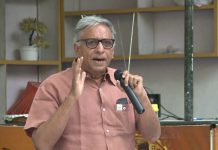Devaki Jain
University students have emerged emphatically into the public space. It started with Rohith Vemula — discrimination against Dalits was the leading point — and then continued in JNU with the leadership of Kanhaiya Kumar. What were the special features of these two young men that made them so articulate and gave them the capacity to lead?
That students and their communities are the strongest and most visible voices of protest, and that students in universities are unionised and often aligned with parties and traditional powers is well-known. At Delhi University in the 1960s when I was there, there were always clashes between various student unions. But their conflicts remained conflicts within the student community. By and large, the issues were about better hostel facilities and other such matters.
But with Rohith and Kanhaiya, there is a difference, which reflects a dramatic change in student populations. The student body is itself different and, in some ways, more “of the earth”. According to Romila Thapar, in JNU in “1971, three years after 1968, which was then quite fresh in all our minds, we had a radical student body that occasionally even gheraoed some of us on some issue or the other — but there was a much more middle class feel to them and most were of the urban middle class. This time, it is different. Although, standing there with Kanhaiya and the others, I felt a whiff of 1968.”
In campuses like JNU, students get accommodation — what is called “B&L”, that is, boarding and lodging. The hostels have many rooms and there is no restriction on when one can enter and exit, as it used to be in some of the earlier colleges. So one aspect of this is the fact that students live together. In many cases, as they go into the PhD programme, they have lived on that campus for some time. There is also the intellectual growth that getting as far as a PhD and then working on a PhD provides. The kind of voice that we hear from Rohith and Kanhaiya is, I would argue, a PhD-experienced voice.
Second, there is now a large section of those who would have, in the past, been “left behind”. They come from the rural hinterland and faraway places. Amongst them are Dalits and students of working-class backgrounds — groups that now have access to university education. For this, one has to pay tribute to reservations and funding that enable such students to enter the university. The fact that Rohith, a Dalit, was able to reach the point of a PhD is due to this enabling mechanism, institutional arrangements and laws that gave him this opportunity.
Living on campus creates a 24X7 student community. I have always found that where students live on campus night and day, there is a certain independence that emerges. They do not have to be accountable to parents, they do not have to go anywhere else for food, they are really free.
I experienced this freedom when I went to live in the hostel of a college in the UK. I felt I could do anything I wanted; there was absolutely no parental oversight nor the anxiety of being well-behaved. I would join the anti-nuclear protest led by Bertrand Russell in Trafalgar Square, ride to London on the pillion of a boyfriend’s motorcycle, stay out all night in the summer in fields with friends. There is no other time in one’s life or space in the world for exercising real freedom, azadi, at the individual level as on a university campus for live-in students.
Thus, Rohith and Kanhaiya represent a situation that has emerged due to the following factors: One, a huge inflow into universities of students from neglected communities and areas. Two, support for the education of excluded groups. Three, the 24-hour community that gets built up in campuses that have boarding facilities.(Indian Express)
















